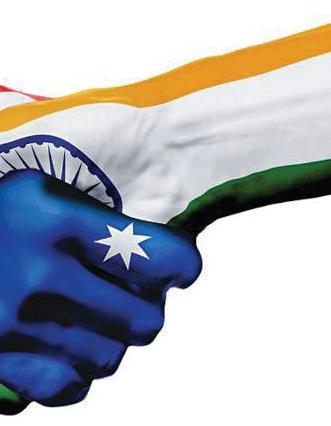
15 minute read
India News-JGU-IAIE SMART program
JGU has signed Memorandums of Understanding (MOUs) with Australia-based INDIA NEWS and Institute for Australia India Engagement (IAIE) to create opportunities for students to undertake internships in Australia. With INDIA NEWS and IAIE students will participate in the Student Mentoring and Research Training (SMART) program over a period of 1-2 months. As a part of the internship students design, edit and publish this page which contains commentaries by them on issues which they deem relevant for Australia-India relations.
Page Editor: Ms. Anushka Saxena, Lady Sri Ram College (graduate), New Delhi
Advertisement
Associate Page Editor: Ms. Vaibhavi Nagar, JGU Commentators: Mr Dhruv Kumar Jha, Ms. Harshita Calla, Ms. Sumedha Maheshwari, Ms. Sri C. Khyati Reddy, Mr. Shivam Shukla and Ms. Tanya Goel ( JGU stu dents and graduates)
India-Australia on Israel-Palestine and the Two-State Solution
Anushka Saxena
The Israel-Palestine Conflict, dating back to the creation of Israel in 1948, has once again come to dominate geopolitical discussions after Hamas, the international terror group in control of the disputed Gaza Strip, fired rockets at Israel following a growth in tensions among settlers in East Jerusalem. The Conflict more-or-less sits at the heart of regional dynamics in the Middle East, and a deadlock situation exists between the state of Israel and the entity of Palestine because while the former is supported vehemently by the United States, the latter has been conferred with bilateral recognition by 139 nations from across the world, especially since Palestine declared its own statehood and independence in 1988.
Both India and Australia have diplomatic relations with Israel, and do not recognise Palestine as a state. Moreover, both India and Australia, recognising the bleak security and human rights situation along the IsraelPalestine axis, support steadfast resolution to the conflict by endorsing what the international community calls the “Two-State Solution”. Having been around the longest - since the British Peel Commission was setup in 1937 to devise a strategy for peaceful coexistence between Israeli Jews and Palestinian Arabs, to having various UN resolutions dedicated to its endorsement - the TwoState Solution seems like the most widely accepted outcome of negotiations and peacemaking between the two parties-toconflict. Albeit it may not be the most logical. But before I move into its “why”, I find it apt to focus on India’s and Australia’s shared stance on the issue in particular. Both India and Australia have positive strategic relations with Israel. India, for example, depends heavily on Israel for its technological and agricultural investments in the country. In 2017 alone, Israeli company ADAMA, before being acquired by Chinese giant ChemChina, invested US $50 million in India in agricultural solutions for crop protection. Similarly, both nations enjoy partnership in the field of space and telecommunications, and this partnership is furthered by Memorandums of Understanding on research and development, as well as industry and commerce, between the two nations. By historical standards, both Indian and Israeli individuals find the other nation to be a good tourist destination, and there exist strong people-topeople ties in both employment and education. Moreover, in defence, India has a lot to learn from the growing drone industry in Israel, and both nations even cooperate on counter terrorism through a Joint Working Group.
In the case of Australia, Israel has witnessed significant support from the country. Historically, Australia was prompt in both, voting in favour of the UN’s 1947 Partition Plan, which eventually led to the formation of Israel, and in establishing diplomatic relations with Israel in 1949. Ever since Australia’s Jewish community has strived to maintain cordiality with the Israelis, and both cultural and technological ties have prospered. Centring around innovation, the investments from both sides in 2019 alone, totalled to the US $1 billion and 542 million. There also exists a special Australia “Trade and Defence Office” in West Jerusalem, since 2019.
With a background of Israel’s relations with India and Australia, we can begin to understand the Two-State Solution. It must be noted that despite the blooming bilateral ties, the Palestine issue and the relevant violations of International Law by Israeli settlers in occupied regions, is always a stumbling block in all of Israel’s worldly ties. Both India and Australia have urged Israel to respect international law, even though the two have been harsher in condemning the actions of the Hamasin Palestine, which also violated international law by disregarding the principle of distinction. Therefore, to bring peace to the region, both nations push forth the Two-State Solution, which essentially divides Israel and Palestine into two independent, internationally recognised states with defined borders. The internationally accepted border is the “Green Line”, first envisioned and laid out by the UN Partition Plan of 1947 (UNGA Resolution 181) and furthered by the Oslo Peace Accords between Israel and Palestine in 1993. Also known as the “Armistice line” of 1949, the border provides for a Palestine comprising the now occupied West Bank, and the Hamas controlled Gaza Strip. While it may seem sensible for the two entities engaged in a state of war since 1948 to exist as separate states for achieving peace, on the ground, its implementation is much more complex.
In a wonderful commentary on the breakdown of the Oslo process of peacebuilding and the alternatives to a Two-State Solution, Khaled Elgindy stated, “That there is international consensus on the need for a two-state solution does not change the fact that Israelis and Palestinians live in a one-state reality.”
This is because of Israel’s huge settlement enterprise, that will now make it virtually impossible for the nation to evacuate lakhs of its settled citizens from the regions meant to belong to Palestine, coupled by the fact that if a Two-State reality does come into action, Palestine as a state will be subject to vulnerability by virtue of territorial discontinuity. Moreover, defined borders will also make it extremely difficult for Palestinian refugees to return to land from where they were evacuated due to Israeli control, or for Israeli Jews to securely visit the land they feel connected with inside the Palestinian territory. On a more practical note, I believe that the idea of “liberating” Palestine into an “Arab (Muslim-dominated) State”, has more to do with the regional sentiments of Arab supremacy and feeling of conquest, than with the actual merits of Palestine existing independently. This feeling has been the leading cause of most Israel-Palestine wars, be it Israel’s pre-emptive strike against joint Egyptian and Syrian forces in 1967 or the 1973 Yom Kippur war, and continues to destabilise the Middle East.
In recent years, more Israelis and Palestinians, as well as the international community are now seeing the Oslo process becoming redundant. The recent protests in West Bank against President of the Palestinian National Authority (PA), Mahmoud Abbas, indicate the PA’s downfall on the Palestinian political scene, and a loosely-tied coalition among various Israeli Parties (both left and right-winged), led by their new Prime Minister - Naftali Bennett, can be the sign of a more moderate and cautious Israeli approach in dealing with Palestine. In this context, it seems rather logical that both Israel and Palestine exist as a symbiotic “One-State”, wherein one and all are guaranteed equal civil, political, cultural and educational rights, accompanied with a right to “free and open national self expression”. At the least, there must exist an economic union of sorts, as was envisioned by the UN Partition Plan. The major challenges to this idea exist in the form of cultural, nationalistic rivalries between Israeli Jew settlers and Palestinian Arabs, as well as the fragmented nature of political fervour within Palestine - as mentioned above, the PA and the Hamas have emerged as two polarising centres of power, furthering discontinuity. However, seeing as prolonged conflict has, more-or-less led to a burnout and a stalemate in the region, the accommodating tendencies are likely to emerge in favour of an egalitarian state for all. It would, however, require not just political, but cultural and social accommodations, and a zeal for conflict-reduction to achieve conflict-resolution.
Impact of COVID-19 on the Australian tourism industry

Harshita Calla
The COVID-19 pandemic came as a shock to the entire world, halting the smooth functioning of many industries, and tourism being one. In the short-term, it has led to a standstill in international visitation, with restrictions being imposed on domestic mobility as well. Australia acted swiftly in its response to the pandemic and as early as late September 2020, as two-thirds of Australians felt that it was now safe to travel within the country.
A similar trend followed in the other aspects of tourism, including the hospitality industry, with various tourist accommodations going into hibernation due to a steep fall in hotel occupancy during March-April of 2020. The steep fall began once the lockdown conditions were eased by June 2020. The same cannot be said for the projects in the pipeline, with the slowing down constructionprojects due to disruptions in the supply chain. Many hotels scheduled to open in 2020 have postponed their launch.
Overall, the tourism industry is mainly catering to domestic travellers only. It has been observed that domestic tourists have started taking shorter and frequent trips, while their travel spending has dropped from an average of $648 per person in 2019 to $385 per person in 2020. Organised tours, convention and conference registrations, taxi services, entertainment, and casinos have seen a reduction of more than 95% in their revenues. The industry is projected to recover and may even reach prepandemic levels soon, but this remains questionable, given the unpredictability of the pandemic and its recurring waves.
Tackling the post-COVID technological growth

Sumedha Maheshwari
The pandemic has been a massive blow for economies around the globe, but on the contrary has led to increased interconnectedness through dependence on technology. Increasingly, relations between countries have also shifted to the digital platform, especially in terms of trade. The pandemic’s end will not bring us ‘back to normal’, but rather, to a world where countries will find themselves cooperating digitally. Technology is the future, and international relations should start focusing on this too.
India’s digital economy is projected to reach US $1 trillion by 2025. Its information technology (IT) sector has been praised for a long time as it shows great promise. It has also made great strides in space and satellite technologies and has given a push to start-ups in the field. Thus, India has a great advantage in this new digital era. Australia, meanwhile, has also invested continuously in strategic defence and technology sectors. It has intensified policy making in this area, like prohibiting ‘high-risk’ vendors from its 5G network in 2018. However, both countries have put adequate safeguards in a digital world, and are struggling to make the transition. Indeed, there lies a huge scope for cooperation.
India and Australia currently have a Framework Arrangement on Cyber and Cyber-Enabled Critical Technologies Cooperation, signed during the Narendra ModiScott Morrison virtual summit in 2020. The agreement in this nascent stage has not seen much partnerships. Several areas need addressing. First, 5G technologies are important to both India and Australia. India sees it as a way to uplift all of its population and create a self-sufficient 5G technology base. For Australia, it will keep its high-value manufacturing sector competitive and provide a better experience to users. However, in both countries, there is not adequate domestic 5G base with Australia outsourcing from Nokia and Ericsson. A partnership would help combat challenges in 5G spectrum like misinformation, and create an environment that would nurture this technology. The second is Artificial Intelligence (AI), which is at a development stage too. If both nations collaborate and invest in research and development, it will speed up India’s plan for smart cities and increase demand for Australia’s critical minerals.
Quantum and space technology are two other areas of importance. In the quantum sector, Australia can supply India with research, training, and investments. Meanwhile, to solidify Australia’s position as a trailblazer in this sector, India can provide human capital with expertise in science, technology, mathematics and more. In space, both are enthusiastic and have made big strides.
Both have growing needs in surveillance and intelligence which, if furthered in a partnership, would lead to better innovation. There is also a lack in both countries’ endeavours in security and monitoring of the space environment. The two countries can better address these challenges by coming together. A final area is improving cooperation between both, on critical minerals and rare earths. Australia and India signed a Memorandum of Understanding (MoU) in June 2020 but investments are still missing.
A bigger picture emerges when these five are put together in the context of the Indo-pacific region. This region is facing strategic challenges linked to the technological sector. There is a need to ensure that technological developments like 5G are collaborative and not used as a leverage by a country over others. The other need is clearly outlining the jurisdiction of technological areas such as in space, so that it doesn’t negatively affect development. Thus, Australia and India are positioned to initiate dialogue on strategies to tackle the security issues in the Indo-Pacific region. But they cannot do it alone. They need to form multilateral relations with other countries. The recent India-France-Australia talks in April 2021 are a step in the right direction. According to reports, there were talks of exploring greater cooperation and solving troubles in the maritime and space regions. However, these initiatives need to be translated into actions rapidly, to face a post-COVID world. Cricket diplomacy galvanising IndiaAustralia comprehensive partnership

Shivam Shukla
India and Australia have several commonalities, which serve as a foundation for closer cooperation and multi-faceted interaction. In the India-Australia bilateral relationship, cricket has been a common factor for decades. Its impact can be observed not just in diplomatic rhetoric, but in wider imaginations of each other as well. Cricket has provided a common connect on which both nations can develop mutual understanding, as both nations have time and again.Cricket has been a tool of soft power which has helped in building positive perceptions among each other. The ever-growing India-Australia bilateral relations, therefore, is drawn upon the cricketing ties. The paramount example of this kind of diplomacy - what some IR scholars term as ‘Cricket Diplomacy’ - was seen during Indian Cricket team’s recent tour of Australia. In the test matches, India secured a comfortable 2-1 victory. Since then, India has captured the imagination of Australians. A young and depleted Team India, without it’s captain Virat Kohli and other key players, became the first team to beat invincible Australia at the Gabba Stadium after 32 years. The victory has described some as a form of 'cricket diplomacy' on various social media outfits, with top leadership of both countries congratulating each other on their performances. For example, Australian PM Scott Morrison tagged his Indian counterpart Narendra Modi and congratulated him for a historical victory. Reciprocating PM Morrison’s gesture, PM Modi tweeted his gratitude and simultaneously utilised the opportunity to strengthen India’s diplomatic ties. He tweeted, "India and Australia make for formidable competitors on the field, and solid partners off it." This exchange of tweets is just another reflection of India's growing economic and political ties with Australia in the wake of their differences with China. In December last year, India released Anil Wadhwa led Australia Economic Strategy (AES) report, in response to Peter Varghese’s India Economic Strategy 2018 which shows deepening bilateral ties. Former Australian cricketer Adam Gilchrist onceaptly commented, “Not many countries can share such a passion and be so culturally different.” Both the countries with significant strategic convergences in — cricket, the commonwealth and English language. Their ties are critical for the IndoPacific region which needs firm commitment towards democratic values, international peace, rule of law, development and multiculturalism, and cricket will remain a potent glue as a soft power in propelling Australia and India in ensuring these commitments.

Future initiatives: AIBX and SCRI

Vaibhavi Nagar
The India-Australia link is traditionally considered to be the weakest amongst the Quad members. However, recent efforts from both countries to deepen economic ties challenge this belief. Despite the pandemicinduced global economic downturn, trade between India and Australia has seen a steady increase. This increase will only be bolstered by the Australia India Business Exchange (AIBX) initiative launched in April 2021. The AIBX aims to provide businesses to both with market insights and networks to foster commercial partnerships that will help generate jobs and business opportunities for the residents of the two countries. Australian Minister for Trade, Tourism, and Investment, Dan Tehan believes that the “AIBX presents opportunities to build on our close people-to-people ties and a shared vision for a secure and prosperous Indo-Pacific. AIBX will give business owners the confidence and capability to engage across our two markets.” The AIBX will assist the countries in the sectors of education, food and agribusiness, healthcare, infrastructure, and mining resources. Under education, this initiative will create opportunities for Australian and Indian providers to collaborate in higher education, transnational education, edtech, research, and vocational and executive skills training. It will help India’s consumers access more of Australia’s premium food and wine products and will allow Australian exporters to build on opportunities in gourmet retail chains, e-commerce, online kitchens, and fine dining. Under healthcare, the AIBX will explore opportunities for the countries to collaborate in areas such as training and skills development, digital health, and joint research and development. It will also enable Australia to provide support and growth to the currently booming Indian mining and resources sector. The AIBX program will be overseen by the Australian Trade and Investment Commission (Austrade) and will include virtual events, in-market activities, and online resources to support Australians and Indians throughout the business exchange. To reduce their dependence on Chinese supply chains, India along with Australia and Japan launched a new initiative in April 2021, called the Supply Chain Resilience Initiative (SCRI). On April 27, 2021, the Ministers of Trade and Commerce from the three countries held a joint video conference acknowledging that the COVID-19 pandemic had a devastating impact on the global economy and had left various supply chains vulnerable to failure. The initial projects of the SCRI include sharing best practices on supply chain resilience and holding investment promotion and buyer-seller matching events to provide opportunities for stakeholders to explore the possibility of diversification of their supply chains. The ministers announced that they will convene at least once every year to further discuss the most effective ways to implement the SCRI and create guidelines for the future development of the initiative. It is anticipated that policies surrounding the SCRI would include enhanced utilization of digital technology and supporting trade and investment diversification. The SCRI aims to strengthen supply chain resilience amongst the three countries and consequently attain strong, sustainable, balanced, and inclusive growth in the region.









